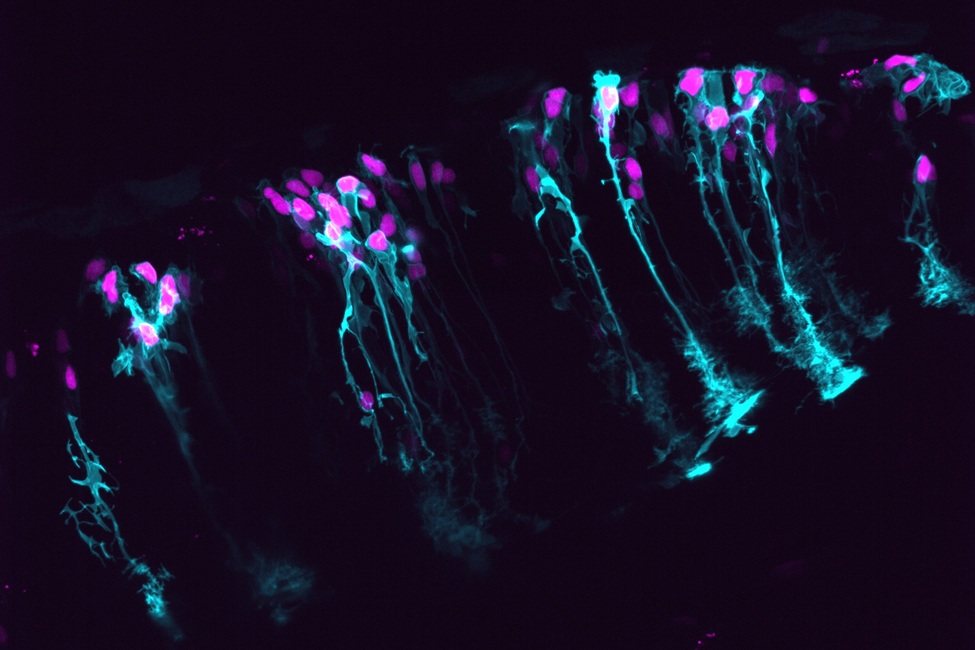AI Reveals Astrocytes Play a 'Starring' Role in Dynamic Brain Function

Image of astroglia, a broad term that includes astrocytes and their progenitor cells.
Long overlooked and underestimated, glial cells – non-neuronal cells that support, protect and communicate with neurons – are finally stepping into the neuroscience spotlight. A new Florida Atlantic University study highlights the surprising influence of a particular glial cell, revealing that it plays a much more active and dynamic role in brain function than previously thought.
Using sophisticated computational modeling and machine learning, researchers discovered how astrocytes, a “star” shaped glial cell, subtly – but significantly – modulate communication between neurons, especially during highly coordinated, synchronous brain activity.
“Clearly, glial cells are significantly implicated in several brain functions, making identifying their presence among neurons an appealing and important problem,” said Rodrigo Pena, Ph.D., senior author, an assistant professor of biological sciences within FAU’s Charles E. Schmidt College of Science on the John D. MacArthur Campus in Jupiter, and a member of the FAU Stiles-Nicholson Brain Institute. “To that end, modeling can be helpful. However, the simulation of the complex interactions between glial cells and neurons is a challenging task that requires advanced computational approaches.”
The research, in collaboration with the Federal University of São Carlos and the University of São Paulo in Brazil, addresses a fundamental gap in neuroscience.
“While neurons have long dominated the conversation, glial cells – and predominantly astrocytes – have been treated as passive support structures. But recent discoveries have challenged this neuron-centric view, suggesting astrocytes are active participants in processes like synaptic modulation, energy regulation and even network coordination,” said Laura Fontenas, Ph.D., co-author, an assistant professor of biological sciences within FAU’s Charles E. Schmidt College of Science on the John D. MacArthur Campus, and a member of the FAU Stiles-Nicholson Brain Institute.
The study, published in the journal Cognitive Neurodynamics, takes those ideas further, showing that astrocytes influence how groups of neurons fire together, especially when the brain is in a “synchronous” state – where large populations of neurons fire in a coordinated rhythm, a condition crucial for functions like attention, memory formation and sleep cycles.
To explore this, the team generated artificial brain network data and applied a suite of machine learning models including Decision Trees, Gradient Boosting, Random Forests, and Feedforward Neural Networks to classify and detect the influence of astrocytes under different network states.
Findings reveal that Feedforward Neural Networks emerged as the most effective, especially in asynchronous (less coordinated) conditions, where capturing subtle patterns required richer and more complex data.
“Our goal was to identify the presence of glial cells in synaptic transmission using different machine-learning methods, which do not require strong assumptions about the data,” said Pena. “We found that the Mean Firing Rate – a common experimental measure – was particularly effective in helping these models detect glial influences, especially when paired with robust algorithms like Feedforward Neural Networks.”
According to Fontenas, the researchers can now investigate these computational findings in appropriate animal models such as in the Zebrafish.
One of the study’s key findings is that astrocytes exert their strongest influence during synchronous brain states. In these conditions, advanced statistical tools such as spike-train coherence, which measures the timing relationships between neural signals, detected a shift toward more coordinated and frequency-diverse firing when astrocytes were present. This suggests that astrocytes not only support but may also fine-tune the rhythmic dynamics of brain networks, potentially contributing to stability and information flow.
“Even with the difficulties of identifying the presence of glial cells, our study highlights the utility of machine learning in detecting their influence within neural networks, particularly by leveraging the Mean Firing Rate as an effective data collection method,” Pena said.
Traditional brain activity metrics like firing rate and coefficient of variation often miss these subtleties. The study shows that although astrocytes affect network behavior, their contributions don’t always produce large changes in conventional measures. As a result, detecting their influence requires more nuanced tools – ones that can see beyond the obvious and identify the deeper patterns in brain activity.
As science continues to unravel the complexities of the human mind, this study is a reminder that some of the brain’s most important contributors have long gone unnoticed. Thanks to machine learning and computational neuroscience, the invisible influence of astrocytes is now coming into view – and with it, a richer, more complete picture of how the brain really works.
“By enhancing our ability to detect glial influence through advanced statistical methods, we open new avenues for exploring how neuron-glia interactions shape brain function,” said Pena. “It’s a critical step toward understanding neurological disorders and could inform future therapies that target not just neurons, but the entire cellular ecosystem of the brain.”
Study co-authors are João Pedro Pirola, first author and a student at the Federal University of São Carlos working in the Pena lab; Paige DeForest, a recent graduate from FAU’s Wilkes Honors College; Paulo R. Protachevicz, Ph.D., University of São Paulo; and Ricardo F. Ferreira, Ph.D., Federal University of São Carlos.
-FAU-
Latest News Desk
- FAU Receives $1.6M Gift for Student Entrepreneur ScholarshipsFlorida Atlantic University received a $1.6 million gift from long-time Boca Raton resident Bob Schattner, which will be used to continue providing scholarships that he established 15 years ago in perpetuity.
- FAU Lands $3M Federal Grant to Prevent Substance Use in At-risk Youth"Rising Strong" will support more than 3,000 South Florida youth with trauma-informed, evidence-based prevention, empowering vulnerable populations to build resilience and choose substance-free futures.
- FAU Research: Logistics Expansion Slows as Transportation Prices DropThe Logistics Managers' Index had the lowest overall reading since March as the supply chain reacts to economic uncertainty, according to researchers from Florida Atlantic University and four other schools.
- World's First Bench-to-Bedside MRI, Focused Ultrasound System UnveiledThe newly expanded FAU NeuroInnovate Center is the first in the world to integrate advanced MRI and focused ultrasound technologies into a single, unified platform for both preclinical and clinical research.
- FAU College of Business to Honor Craig ZinnFlorida Atlantic University's College of Business is hosting its 31st "Business Leader of the Year" breakfast to honor the accomplishments of Craig Zinn of Craig Zinn Automotive Group.
- Beyond the Pink Ribbon: Combating Breast Cancer in Younger WomenFAU researchers are investigating rising breast cancer in younger women. Four young survivors' stories highlight missed signs, emotional toll, and the urgent need for earlier detection and evidence-based care.






